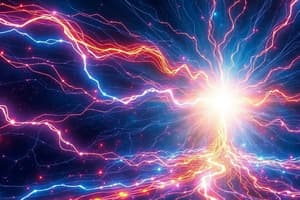Podcast
Questions and Answers
What is the unit used to measure the strength of a magnetic field?
What is the unit used to measure the strength of a magnetic field?
- Teslas (T) (correct)
- Watts (W)
- Amperes (A)
- Volts per meter (V/m)
Which of the following best describes an electric field?
Which of the following best describes an electric field?
- A phenomenon that is independent of magnetism
- A vector field associated with moving electric charges
- A vector field that surrounds a charged object (correct)
- A force that exerts on other moving charges
How are the magnetic fields of two magnets oriented when they repel each other?
How are the magnetic fields of two magnets oriented when they repel each other?
- The north and south poles are facing each other
- The north poles are facing each other (correct)
- The magnetic fields are not aligned
- The south poles are facing each other
Which of the following is an application of electromagnetism?
Which of the following is an application of electromagnetism?
What is the relationship between electricity and magnetism according to the text?
What is the relationship between electricity and magnetism according to the text?
What is the name of the vector that represents the directional energy flux density of an electromagnetic field?
What is the name of the vector that represents the directional energy flux density of an electromagnetic field?
Which of the following materials is typically used as the core in an electromagnet?
Which of the following materials is typically used as the core in an electromagnet?
What is the purpose of the brushes and commutator in an electric motor?
What is the purpose of the brushes and commutator in an electric motor?
Which of the following is not a common application of electromagnetism?
Which of the following is not a common application of electromagnetism?
What is the relationship between the strength of the magnetic field produced by an electromagnet and the amount of current flowing through the coil?
What is the relationship between the strength of the magnetic field produced by an electromagnet and the amount of current flowing through the coil?
Flashcards are hidden until you start studying
Study Notes
Electromagnetism
Electromagnetism is a branch of physics that studies the interaction between electric charges and magnetic fields. It encompasses two related phenomena - electricity and magnetism - which are interdependent and often occur together. Understanding electromagnetism is crucial for the development of technology that relies on electric and magnetic fields, such as motors, generators, transformers, and even wireless communication devices like cell phones and WiFi routers.
Magnetic Fields
A magnetic field is a vector field associated with moving electric charges, such as electrons. It exerts forces on other moving charges and affects the motion of charged particles. The strength of a magnetic field is typically measured in teslas (T), and it is often represented by the symbol B. Magnets, which are objects with strong magnetic fields, can attract or repel each other depending on the orientation of their magnetic fields.
Electric Fields
An electric field is a vector field that surrounds a charged object. It is caused by the presence of a charged object and exerts a force on other charges. The strength of an electric field is typically measured in volts per meter (V/m), and it is often represented by the symbol E. Electric fields can be either positive (repelling charges) or negative (attracting charges).
Electromagnetic Field Strength
The strength of an electromagnetic field is a measure of the intensity of the electric and magnetic fields that make up the electromagnetic field. The strength of an electromagnetic field is often described using the Poynting vector, named after the physicist J.H. Poynting. The Poynting vector is a vector quantity that represents the directional energy flux density of an electromagnetic field.
Parts of an Electromagnet
An electromagnet is a type of magnet that is made of a wire coil wrapped around a core. The core is usually made of a ferromagnetic material like iron or steel, which enhances the magnetic field produced by the coil. The strength of the magnetic field produced by an electromagnet depends on several factors, including the number of turns in the coil, the amount of current flowing through the coil, and the type of core material used.
Parts of an Electric Motor
An electric motor is a machine that converts electrical energy into mechanical energy. It consists of several parts, including:
- Stator: This is the stationary part of the motor, which typically consists of a series of wire coils wrapped around a core.
- Rotor: This is the rotating part of the motor, which is typically a conducting material like copper.
- Brushes and Commutator: These components are used to make and break the electrical connection between the rotor and the stator, allowing the motor to rotate.
- Field poles: These are magnets or electromagnets that create the magnetic field needed to move the rotor.
Applications of Electromagnetism
Electromagnetism has a wide range of applications in various fields, including:
- Electric motors and generators: These devices use the principles of electromagnetism to convert electrical energy into mechanical energy or vice versa.
- Transformers: These devices use electromagnetism to step up or step down the voltage of an electric current.
- Wireless communication: The principles of electromagnetism are used in devices like cell phones and WiFi routers to transmit and receive radio waves.
- Medical imaging: Technologies like MRI (Magnetic Resonance Imaging) and CT (Computed Tomography) scans use electromagnetism to produce detailed images of the body's internal structures.
- Electronic devices: Many electronic devices, such as televisions, computers, and smartphones, rely on the principles of electromagnetism for their operation.
In conclusion, electromagnetism is a fundamental concept in physics that underpins a wide range of technological applications. By understanding the interactions between electric charges and magnetic fields, scientists and engineers can design and build devices that harness these forces for various purposes, transforming our world in countless ways.
Studying That Suits You
Use AI to generate personalized quizzes and flashcards to suit your learning preferences.




